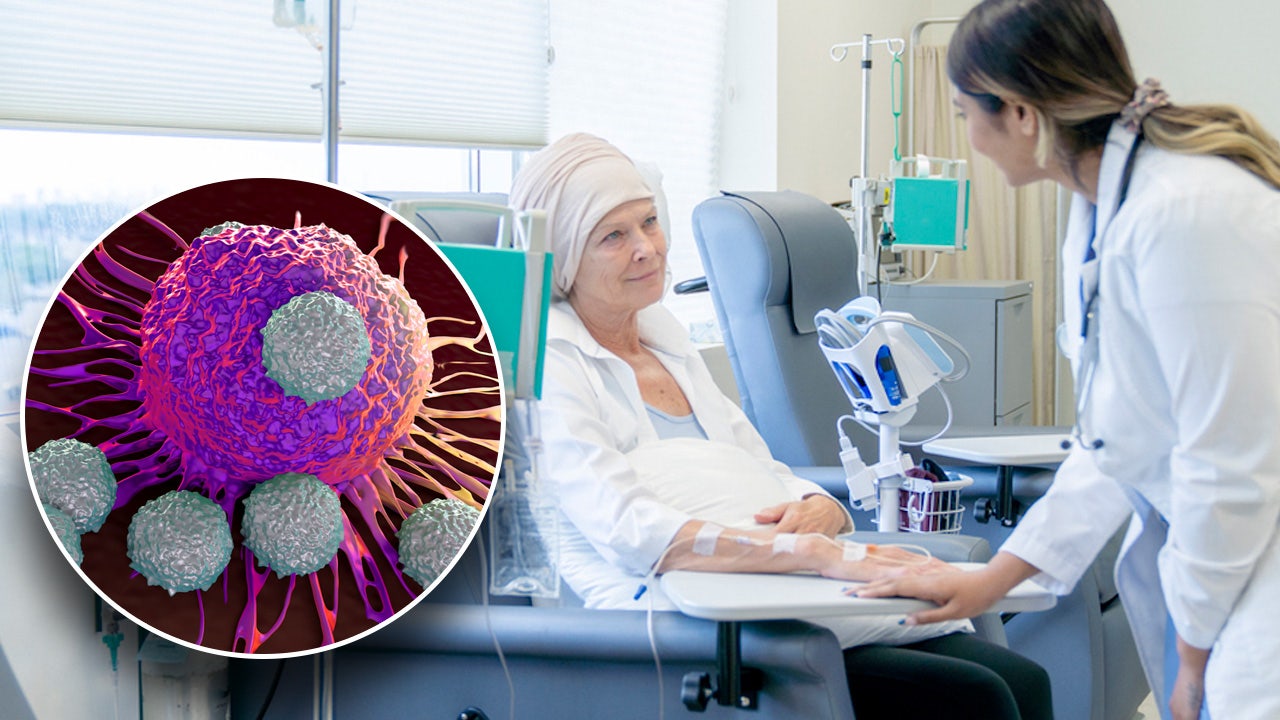Health
Novel cancer treatment offers new hope when chemo and radiation fail: ‘Big change in people’s lives’

When it comes to cancer treatments, most people are familiar with chemotherapy, radiation and surgery.
Yet there is another emerging, lesser-known therapy that is showing promising results in treating blood cancers.
With CAR T-cell therapy, the patient’s T-cells are taken from the blood, engineered to attack cancer cells and then infused back into the patient’s body through an IV, Dr. Noopur Raje told Fox News Digital.
Raje is director of the Center for Multiple Myeloma at Massachusetts General Hospital, which has a Gene and Cell Therapy Institute that offers CAR T-cell therapy.
JUST 4 MINUTES OF INTENSE DAILY ACTIVITY COULD SLASH CANCER RISK AMONG ‘NON-EXERCISERS,’ STUDY FINDS
“I think it’s made a big change in people’s lives and how we take care of people,” she told Fox News Digital in an interview.
“It’s one of the most personalized ways of taking care of some of the blood-related cancers.”
Dr. Noopur Raje is director of the Center for Multiple Myeloma at Massachusetts General Hospital, which has a Gene and Cell Therapy Institute that offers CAR T-cell therapy. “It’s one of the most personalized ways of taking care of some of the blood-related cancers,” she said of the therapy. (Mass General Cancer Center)
At Mass General, Raje and her team treat patients with multiple myeloma, a rare form of blood cancer that attacks the plasma cells.
Most of their patients are between 60 and 70 years old, she said.
What is CAR T-cell therapy?
CAR stands for chimeric antigen receptors, which are proteins that enable T-cells to target the tumor antigens produced by cancer cells.
T-cells are a type of white blood cell that helps to fight germs and prevent disease, per the Cleveland Clinic.
There are currently six CAR T-cell therapies that are FDA-approved to treat leukemia, lymphomas, multiple myeloma and other blood cancers.

As of now, the FDA has approved CAR T-cell therapy as a “last resort” when the disease has persisted through all other available treatments. (iStock)
“We are taking our patients’ T-cells, which are the immune cells, and then activating them and putting a chimeric antigen receptor (CAR), which can recognize a protein on a cancer tumor,” Raje said.
CANCER BLOOD TEST USING DNA FRAGMENTS BRINGS HOPE FOR EARLIER DETECTION, SAY RESEARCHERS
Because Raje treats multiple myeloma, her team started off by doing studies against a protein called BCMA, which is found in cancerous plasma cells.
The re-engineered T-cells continue multiplying in the body, so they can seek out and kill more tumor cells, the doctor said.

With CAR T-cell therapy, the patient’s T-cells are taken from the blood, engineered to attack cancer cells and then infused back into the patient’s body through an IV. (iStock)
“We are seeing extremely high response rates, between 82% and 100%,” she told Fox News Digital. “Now we need to do a better job of maintaining that response.”
Before CAR T-cell therapy, Raje said, patients were started on a treatment and then stayed on it for an indefinite length of time.
“This is the first time that patients are getting a ‘one-off’ treatment, and then we’re just watching them with no more treatment at all,” she said.
Once the process is complete, the patient receives no new therapies for up to three years.
While the treatment can be a little “involved” at the beginning, Raje said, once it’s complete the patient receives no new therapies for up to three years.
“And I have some patients who are on no treatment for way longer than that, which is a big advancement,” she added.
“Obviously, we need to do better — we need to cure people,” Raje said.
“We’re not quite there, but the next step is to start the treatment earlier, so we can start seeing more control of the disease over a longer period of time.”

Sandy Caterine is pictured leaving the hospital after receiving CAR T-cell therapy in 2019. (Sandy Caterine)
As of now, the FDA has approved CAR T-cell therapy as a “last resort” when the disease has persisted through all other available treatments; but Raje hopes that soon, it will be available to patients earlier in the course of their cancers.
CAR T-cell therapy is expensive — costing anywhere from $500,000 to $1,000,000, per WebMD. Raje pointed out, however, that many insurance plans cover at least some of the cost. It is also covered by Medicare.
“I think one has to start looking at the time saved in terms of quality of life in not coming back to the hospital and not being on any other meds,” she said.
AI TECH AIMS TO DETECT BREAST CANCER BY MIMICKING RADIOLOGISTS’ EYE MOVEMENTS: ‘A CRITICAL FRIEND’
There is some risk of side effects for those receiving CAR T-cell therapy, primarily a condition called cytokine release syndrome (CRS). It can occur when the immune system responds too aggressively to infection.
“When the CAR T-cell kills the tumor, it produces a bunch of proteins, and when it does that, it can make you quite sick,” Raje said.

Sandy Caterine of New Hampshire (center in green dress) is pictured with her extended family in June 2021 after her successful CAR T-cell therapy. (Sandy Caterine)
“But as we’ve used more and more of these therapies, we’ve gotten pretty good at managing this, and we have the antidotes for these kinds of toxicities,” she added.
Another potential side effect is a condition called ICANS, or immune effector-mediated neurotoxicity.
“With this, people can get confused, sometimes to the extent that they can actually go into a deep coma,” Raje said. “It’s important to recognize and treat these conditions earlier.”
One woman’s story: ‘A great response’
Sandy Caterine, a retired accountant who lives in Rye, New Hampshire, was part of a clinical trial for CAR T-cell therapy.
She was diagnosed with multiple myeloma in August 2019.
UTERINE CANCER DEATHS COULD SOON OUTNUMBER DEATHS FROM OVARIAN CANCER, ONCOLOGIST SAYS: ‘WE NEED TO DO BETTER’
“It kind of came out of nowhere,” Caterine told Fox News Digital. “In retrospect, maybe I had a couple of little symptoms.”
Caterine had experienced some back pain, fatigue and nausea, but initially chalked it up to dehydration.
When the symptoms didn’t go away on their own, she saw her primary care physician and got some blood tests, which led to her diagnosis.

Sandy Caterine is pictured visiting her grandson in New Orleans in 2023. (Sandy Caterine)
“I had never even heard of multiple myeloma,” Caterine said. “All I heard was that it was incurable and no one could predict what the life expectancy might be.”
For several months, Caterine was on a regimen of numerous drugs, infusions and radiation, none of which fully resolved her cancer. Then she learned about the clinical trial for CAR T-cell therapy.
“Sandy has what is known as high-risk disease, based on the genetics of the cancer,” said Raje. “This usually doesn’t have good outcomes, but Sandy had a great response to the trial.”
TWO NEW CANCER PILLS SHOW ‘UNPRECEDENTED’ RESULTS IN BOOSTING SURVIVAL RATES AND PREVENTING RECURRENCE
Caterine, who is 62, did experience the CRS illness as a side effect, which caused her to endure nausea, fatigue, fever and disorientation.
She remained in the hospital for 15 days.
“It took me a while to get my strength back,” she said. “I do remember them taking very good care of me.”
Caterine has gotten periodic bone marrow scans every three months since her infusion.

Sandy Caterine (center, right, near Mickey’s ear) is pictured in February 2023 with her daughter, her sister and her family. (Sandy Caterine)
“So far, there has been no sign of the disease,” she said.
“Dr. Raje told me the hope was that it would work for two to three years, and I am already over two years.”
Caterine’s experience has helped her appreciate each day more than she did before, she told Fox News Digital.
“It’s probably the most personalized way of being able to take care of your own disease.”
“These are two years that I never thought I would get when I was first diagnosed,” she said.
“It’s just great that I can continue to live my life and be with my family.”
Future of CAR T-cell therapy
CAR T-cell therapy started out for use in leukemia, later branching out to other blood cancers like lymphoma and multiple myeloma.
Raje is hopeful that the treatment eventually will become available for other types of cancers, including cancers of the breast, colon and brain.
CLICK HERE TO SIGN UP FOR OUR HEALTH NEWSLETTER
“We have an ongoing study where we are looking at CAR T-cell therapy in glioblastoma, a type of brain cancer, which we would have never thought of doing early on,” she said.
“And we have a whole host of new CARs coming down the pike against different antigens.”
“Obviously, we need to do better — we need to cure people.”
The doctor emphasized the significance of teaching the body’s own immune cells to fight against cancer cells.
“In my mind, it’s probably the most personalized way of being able to take care of your own disease, which is amazing,” she said.

Health
Kennedy’s Plan for the Drug Crisis: A Network of ‘Healing Farms’

Though Mr. Kennedy’s embrace of recovery farms may be novel, the concept stretches back almost a century. In 1935, the government opened the United States Narcotic Farm in Lexington, Ky., to research and treat addiction. Over the years, residents included Chet Baker and William S. Burroughs (who portrayed the institution in his novel, “Junkie: Confessions of an Unredeemed Drug Addict”). The program had high relapse rates and was tainted by drug experiments on human subjects. By 1975, as local treatment centers began to proliferate around the country, the program closed.
In America, therapeutic communities for addiction treatment became popular in the 1960s and ’70s. Some, like Synanon, became notorious for cultlike, abusive environments. There are now perhaps 3,000 worldwide, researchers estimate, including one that Mr. Kennedy has also praised — San Patrignano, an Italian program whose centerpiece is a highly regarded bakery, staffed by residents.
“If we do go down the road of large government-funded therapeutic communities, I’d want to see some oversight to ensure they live up to modern standards,” said Dr. Sabet, who is now president of the Foundation for Drug Policy Solutions. “We should get rid of the false dichotomy, too, between these approaches and medications, since we know they can work together for some people.”
Should Mr. Kennedy be confirmed, his authority to establish healing farms would be uncertain. Building federal treatment farms in “depressed rural areas,” as he said in his documentary, presumably on public land, would hit political and legal roadblocks. Fully legalizing and taxing cannabis to pay for the farms would require congressional action.
In the concluding moments of the documentary, Mr. Kennedy invoked Carl Jung, the Swiss psychiatrist whose views on spirituality influenced Alcoholics Anonymous. Dr. Jung, he said, felt that “people who believed in God got better faster and that their recovery was more durable and enduring than people who didn’t.”
Health
Children exposed to higher fluoride levels found to have lower IQs, study reveals

The debate about the benefits and risks of fluoride is ongoing, as RFK Jr. — incoming President Trump’s pick for HHS secretary — pushes to remove it from the U.S. water supply.
“Fluoride is an industrial waste associated with arthritis, bone fractures, bone cancer, IQ loss, neurodevelopmental disorders and thyroid disease,” RFK wrote in a post on X in November.
A new study published in JAMA Pediatrics on Jan. 6 found another correlation between fluoride exposure and children’s IQs.
RFK JR. CALLS FOR REMOVAL OF FLUORIDE FROM DRINKING WATER, SPARKING DEBATE
Study co-author Kyla Taylor, PhD, who is based in North Carolina, noted that fluoridated water has been used “for decades” to reduce dental cavities and improve oral health.
Fluoride exposure has been linked to a variety of negative health effects, yet benefits oral health. (iStock)
“However, there is concern that pregnant women and children are getting fluoride from many sources, including drinking water, water-added foods and beverages, teas, toothpaste, floss and mouthwash, and that their total fluoride exposure is too high and may affect fetal, infant and child neurodevelopment,” she told Fox News Digital.
The new research, led by scientists at the National Institute of Environmental Health Sciences (NIEHS), analyzed 74 epidemiological studies on children’s IQ and fluoride exposure.
FEDERAL JUDGE ORDERS EPA FURTHER REGULATE FLUORIDE IN DRINKING WATER DUE TO CONCERNS OVER LOWERED IQ IN KIDS
The studies measured fluoride in drinking water and urine across 10 countries, including Canada, China, Denmark, India, Iran, Mexico, Pakistan, New Zealand, Spain and Taiwan. (None were conducted in the U.S.)
The meta-analysis found a “statistically significant association” between higher fluoride exposure and lower children’s IQ scores, according to Taylor.
“[It showed] that the more fluoride a child is exposed to, the more likely that child’s IQ will be lower than if they were not exposed,” she said.

Scientists found a “statistically significant association” between higher fluoride exposure and lower children’s IQ scores. (iStock)
These results were consistent with six previous meta-analyses, all of which reported the same “statistically significant inverse associations” between fluoride exposure and children’s IQs, Taylor emphasized.
The research found that for every 1mg/L increase in urinary fluoride, there was a 1.63-point decrease in IQ.
‘Safe’ exposure levels
The World Health Organization (WHO) has established 1.5mg/L as the “upper safe limit” of fluoride in drinking water.
“There is concern that pregnant women and children are getting fluoride from many sources.”
Meanwhile, the U.S. Public Health Service recommends a fluoride concentration of 0.7 mg/L in drinking water.
“There was not enough data to determine if 0.7 mg/L of fluoride exposure in drinking water affected children’s IQs,” Taylor noted.
FDA BANS RED FOOD DYE DUE TO POTENTIAL CANCER RISK
Higher levels of the chemical can be found in wells and community water serving nearly three million people in the U.S., the researcher noted.
She encouraged pregnant women and parents of small children to be mindful of their total fluoride intake.

Nearly three million people have access to wells and community water with fluoride levels above the levels suggested by the World Health Organization. (iStock)
“If their water is fluoridated, they may wish to replace tap water with low-fluoride bottled water, like purified water, and limit exposure from other sources, such as dental products or black tea,” she said.
“Parents can use low-fluoride bottled water to mix with powdered infant formula and limit use of fluoridated toothpaste by young children.”
For more Health articles, visit www.foxnews.com/health.
While the research did not intend to address broader public health implications of water fluoridation in the U.S., Taylor suggested that the findings could help inform future research into the impact of fluoride on children’s health.
Dental health expert shares cautions
In response to this study and other previous research, Dr. Ellie Phillips, DDS, an oral health educator based in Austin, Texas, told Fox News Digital that she does not support water fluoridation.

The study researcher encouraged parents of small children to be mindful of their total fluoride intake. (iStock)
“I join those who vehemently oppose public water fluoridation, and I question why our water supplies are still fluoridated in the 21st century,” she wrote in an email.
“There are non-fluoridated cities and countries where the public enjoy high levels of oral health, which in some cases appear better than those that are fluoridated.”
CLICK HERE TO SIGN UP FOR OUR HEALTH NEWSLETTER
Phillips called the fluoride debate “confusing” even among dentists, as the American Dental Association (ADA) advocates for fluoride use for cavity prevention through water fluoridation, toothpaste and mouthwash — “sometimes in high concentrations.”

Fluoride is used in water, toothpaste and mouthwash to help prevent cavities. (iStock)
“[But] biologic (holistic) dentists generally encourage their patients to fear fluoride and avoid its use entirely, even if their teeth are ravaged by tooth decay,” she said.
“Topical fluoride is beneficial, while systemic consumption poses risks.”
Phillips encouraged the public to consider varying fluoride compounds, the effect of different concentrations and the “extreme difference” between applying fluoride topically and ingesting it.
“Topical fluoride is beneficial, while systemic consumption poses risks,” she cautioned.
“Individuals must take charge of their own oral health using natural and informed strategies.”
The study received funding from the National Institute of Environmental Health Sciences (NIEHS), the National Institutes of Health (NIH) and the Intramural Research Program.
Health
Treating Other Diseases With Ozempic? Experts Weigh In | Woman's World

Sign Up
Create a free account to access exclusive content, play games, solve puzzles, test your pop-culture knowledge and receive special offers.
Already have an account? Login
Use left and right arrow keys to navigate between menu items.
Use escape to exit the menu.
-
/cdn.vox-cdn.com/uploads/chorus_asset/file/25822586/STK169_ZUCKERBERG_MAGA_STKS491_CVIRGINIA_A.jpg)
/cdn.vox-cdn.com/uploads/chorus_asset/file/25822586/STK169_ZUCKERBERG_MAGA_STKS491_CVIRGINIA_A.jpg) Technology1 week ago
Technology1 week agoMeta is highlighting a splintering global approach to online speech
-

 Science7 days ago
Science7 days agoMetro will offer free rides in L.A. through Sunday due to fires
-
/cdn.vox-cdn.com/uploads/chorus_asset/file/23935558/acastro_STK103__01.jpg)
/cdn.vox-cdn.com/uploads/chorus_asset/file/23935558/acastro_STK103__01.jpg) Technology7 days ago
Technology7 days agoAmazon Prime will shut down its clothing try-on program
-

 News1 week ago
News1 week agoMapping the Damage From the Palisades Fire
-

 News1 week ago
News1 week agoMourners Defy Subfreezing Temperatures to Honor Jimmy Carter at the Capitol
-
/cdn.vox-cdn.com/uploads/chorus_asset/file/25826211/lorealcellbioprint.jpg)
/cdn.vox-cdn.com/uploads/chorus_asset/file/25826211/lorealcellbioprint.jpg) Technology6 days ago
Technology6 days agoL’Oréal’s new skincare gadget told me I should try retinol
-
/cdn.vox-cdn.com/uploads/chorus_asset/file/25832751/2192581677.jpg)
/cdn.vox-cdn.com/uploads/chorus_asset/file/25832751/2192581677.jpg) Technology3 days ago
Technology3 days agoSuper Bowl LIX will stream for free on Tubi
-

 Business4 days ago
Business4 days agoWhy TikTok Users Are Downloading ‘Red Note,’ the Chinese App

















